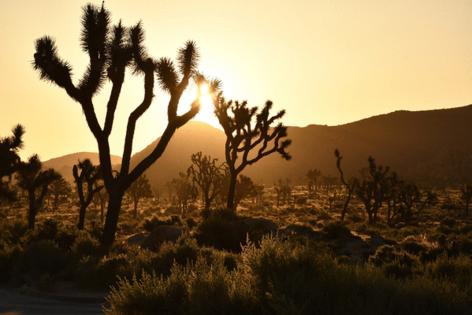California approves an unprecedented plan to protect Joshua trees from climate change threats
Published in Science & Technology News
A sweeping conservation plan identifies where Joshua trees may survive in a warmer future and plots out how to best protect that land.
Proponents say it’s the first time the state has taken steps to conserve a species that’s abundant now but is projected to lose much of its future habitat due to climate change.
Some fear the plan and the law that required it will stifle growth and drive up the cost of living.
California has approved an unprecedented plan to protect the iconic Joshua tree from climate change and development.
The western Joshua tree conservation plan is a broad blueprint that compiles scientific research and traditional ecological knowledge to identify areas where the plant may thrive in a warmer future and plot out how to best protect that land. It recommends limiting development, taking steps to reduce wildfire risk like culling invasive grasses and introducing Joshua trees with genetic variations that make them more resilient to warming temperatures.
The plan was required by a state law enacted in 2023 and received final approval Wednesday at a Fish and Game Commission meeting. Proponents say the effort is groundbreaking because it seeks to conserve a species that’s abundant now but is projected to lose much of its habitat to climate change.
“This is the first time I’ve ever seen the Legislature and governor take this step to protect a species that may be imperiled in future,” said Isabel Baer, acting manager of the California Department of Fish and Wildlife habitat conservation planning branch. The department is tasked with carrying out and enforcing regulations set by the Fish and Game Commission and providing information to inform its decisions.
The forward-looking nature of the plan and underlying law has fueled controversy, with some local residents and politicians pointing out that the tree is currently ubiquitous in some high desert communities and questioning why it needs protecting. The law also requires property owners to obtain permits and pay fees to kill, damage or remove Joshua trees, which some fear will stifle growth and drive up the cost of living in some of the last affordable regions in Southern California.
San Bernardino County Supervisor Dawn Rowe, whose district includes communities surrounding Joshua Tree National Park, said the law has already stalled housing and infrastructure projects and driven away desperately-needed jobs and investments.
“The Western Joshua Tree Conservation Act is a blunt instrument that threatens the future of the Morongo Basin and other desert communities by imposing costly, inflexible regulations,” Rowe said in a statement. “It was written and passed by legislators with no ties to our community, who have never seen how the Joshua tree thrives and is intricately interwoven into our developed areas.”
The conservation plan has drawn criticism from a coalition of local water agencies, a residents’ organization and trade groups representing Realtors and farmers, who last month sent a letter to the state that called the plan “untried, and in numerous respects very confusing.” The letter demanded changes in the implementation of the plan, including exemptions or expedited permitting for projects like water distribution system repairs and maintenance.
“Doing so would help reduce the disproportionate and harmful impacts on affected communities and public agencies during this experimental effort to conserve a species based solely on climate change projections,” the letter states.
There are two distinct species of Joshua trees — referred to as “eastern” and “western” — that grow in California, Arizona, Nevada, Utah and Mexico. The spiky succulents are revered for their cultural import, having inspired both a namesake national park and a U2 album. They have served as a guide for Indigenous people in both a physical and spiritual sense, with some tribes using their roots for basketry, their fibers for cordage and their petals and fruits for food, said Robert Przeklasa, executive director of the Native American Land Conservancy. The nonprofit was a partner in the creation of the plan, buoyed by a grant from the Wildlife Conservation Board that enabled tribal members to be compensated for their time and travel.
The trees are also a linchpin of the Mojave Desert ecosystem. Dozens of animals rely on them to survive, from ladder-backed woodpeckers who nest in their trunks to desert night lizards who sleep and forage beneath their fallen boughs.
Yet more than a third of the western species’ range in California is private land and includes some of the fastest-growing communities in the region, according to state scientists. On top of that, climate models clearly show there won’t be much suitable habitat left by the end of the century, scientists say.
“This plan is a major milestone in efforts to protect one of California’s most ecologically important and iconic species that’s facing a very, very difficult future,” said Brendan Cummings, conservation director of the Center for Biological Diversity. The nonprofit petitioned to list the western Joshua tree as threatened under the state Endangered Species Act in 2019. The Western Joshua Tree Conservation Act was enacted after the Fish and Game Commission deadlocked on whether to do so.
That law requires people who perform work that kills all or part of a Joshua tree to receive a permit and to pay mitigation fees for each tree harmed. Exactly how close a person can dig to a Joshua tree before the work triggers the fee and permitting requirements is determined by CDFW staff on a case-by-case basis depending on the project, Baer said.
Those fees can add up quickly for even small projects.
Alec Mackie owns three lots in Yucca Valley and wants to build his retirement home on one of them. But now he may not be able to, because there are 88 Joshua trees on the property — and his plan would require removing eight of them.
The state reviewed his proposed construction project, said he must pay mitigation fees for 63 trees, and sent him a bill for $32,961.75. Mackie was also required to pay about $4,000 for the tree census, which covered two lots. And he must commission arborist reports and pay for contractor training, which he’s estimating will cost another $4,000.
Worse yet, Mackie said, since 55 of the trees will remain standing, he will have to pay again to dig near them if he wants to undertake another construction project in the future.
He’s now considering abandoning the project.
Baer said the state has been working with towns and residents to address these types of concerns. They’ve already exempted single-family home projects from a previous requirement to relocate certain Joshua trees and are working on preparing an environmental impact analysis that will make the permitting process easier and less costly, she said. The plan is also expected to evolve, as the Fish and Game Commission is required to review its effectiveness at public meetings next year and every two years after that. In eight years, the commission will reconsider whether to list the Joshua tree under the state Endangered Species Act.
“Hopefully we’ll have met our goals under the plan to where the species doesn’t need that protection,” Baer said.
©2025 Los Angeles Times. Visit at latimes.com. Distributed by Tribune Content Agency, LLC.







Comments